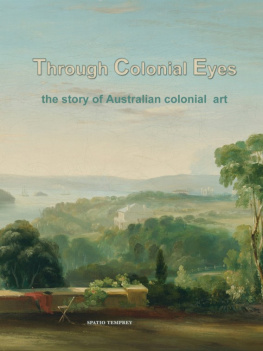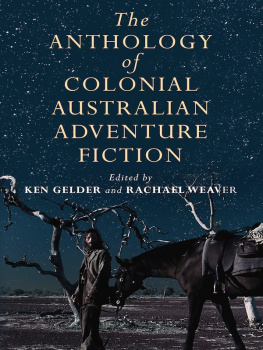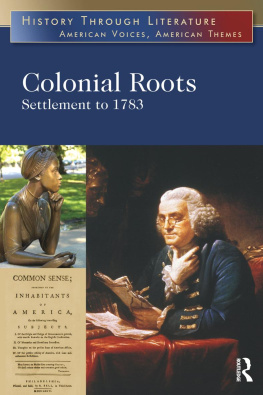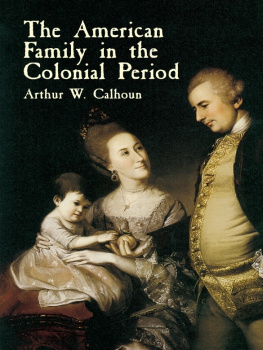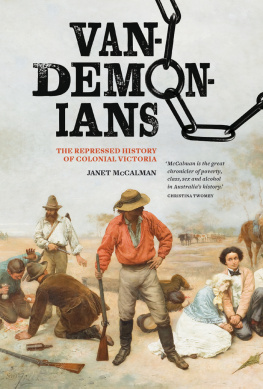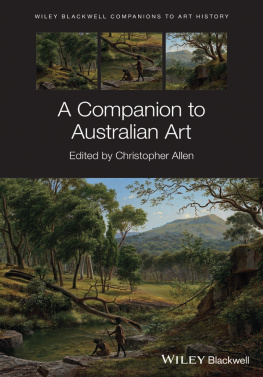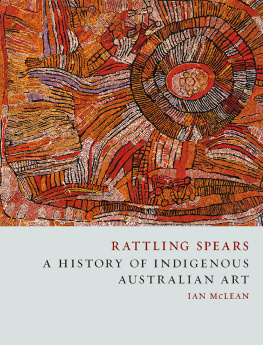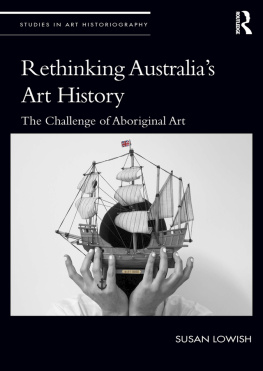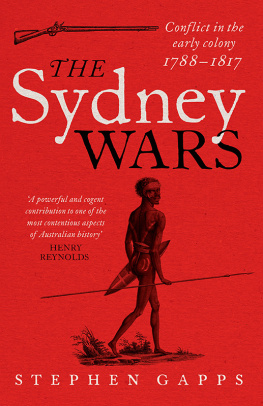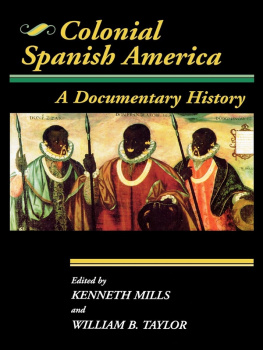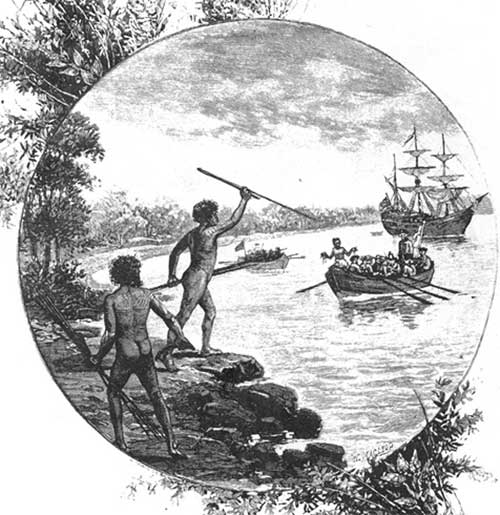
A 19th century engraving ofnatives of the Gweagal tribe opposing the arrival of Captain JamesCook in 1770
Through Colonial Eyes
The story of Australia colonialart
By Spatio Temprey
Smashwords Edition
Copyright 2014 Spatio Temprey
Smashwords Edition, License Notes.This ebook is licensed for your personal enjoyment only. This ebookmay not be re-sold or given away to other people. If you would liketo share this book with another person, please purchase anadditional copy for each recipient. If youre reading this book anddid not purchase it, or it was not purchased for your use only,then please return to Smashwords.com and purchase your own copy.Thank you for respecting the hard work of this author.
Through colonial eyes: the story ofAustralian colonial art
Ozbox Design 2014 V 1

About this ebook
The images used in this publication are in thepublic domain because their copyright has expired. This applies toAustralia, the United States, the European Union and thosecountries with a copyright term of life of the author plus 70years.
While reasonable effort has been made to identifyand acknowledge all sources in this ebook, any queries aboutomissions or errors are welcome.
The content of this publication has been created foreducational purposes and is aimed at upper secondary school level.At the same time, it seeks to promote appreciation andunderstanding of art for the general interested reader. Thismaterial has been tested and refined in the classroom.
This book uses standard Australian Englishspelling.
Student activities
Learning activities have been created for use withthis publication and can be purchased separately (Throughcolonial eyes student activity booklet). The activities aretaxonomically structured, starting with a straightforwardrequirement of reading the text and responding to questions,finding specific significant items of information, through toanalysis of artworks then culminating in an essay that requiresstudents to exercise their judgment and argue a case from arthistory based on what they have learned. Students who work with theactivities are provided with a thorough familiarisation of thecontent and guided through an understanding of the significantconcepts of this period of Australian art history. At the sametime, students are immersed and engaged in the discourse andmethodology of art and art history. Using the workbook, studentscan work independently and complete this art history topic in theirown time, thus liberating valuable time for studio work.
Links
There are links in this publication connecting artworks to further information on the internet. These links are towhat are likely to be permanent sites. Should any of these happento be taken offline we would be grateful for notification.
About the author
Spatio Temprey (Dip. Fine Art, BEd, BA [art historyand philosophy], MEd) is an art educator with many years experienceteaching upper secondary school, and in instructional design.
Other titles in Smashwords by this author
Manets Women
Inside Matisse
Contact
We welcome queries about this ebook. Contact thepublisher via .
Cover design with detail of ConradMartens View from Rose Bank 1840
Contents
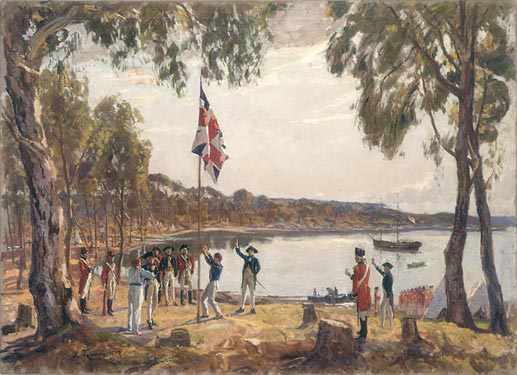
The founding of Australia. ByCapt. Arthur Phillip R.N. Sydney Cove, Jan. 26th 1788original[oil] sketch [1937] by Algernon Talmage R.A. (State Library ofNSW)
Introduction
What was the colonial art period inAustralia?
T he colonial period beganwith the first settlement of Australia. Governor Phillip claimedthe land as a British colony when he landed at Sydney Cove onSaturday 26 January 1788.
The colonial period officially ended with Federationon Tuesday 1 January 1901 but for art history purposes, it endedearlier with the appearance of what is called the Heidelberg Schoolof painters from 1886. This was the centenary period (100 yearsafter settlement). At this time artists began to paint in a selfconsciously Australian manner and in correspondence withAustralias growing sense of identity and nationhood.
This book divides colonial art into threesections.
Precolonial Australian prehistory, discovery andprecolonial art up to 1788
Early colonial from 1788 to about 1860
Late colonial 1860s to the beginnings of theHeidelberg School in the 1880s
Precolonial
Australian prehistory and discovery
Australian prehistory and discoverytimeline
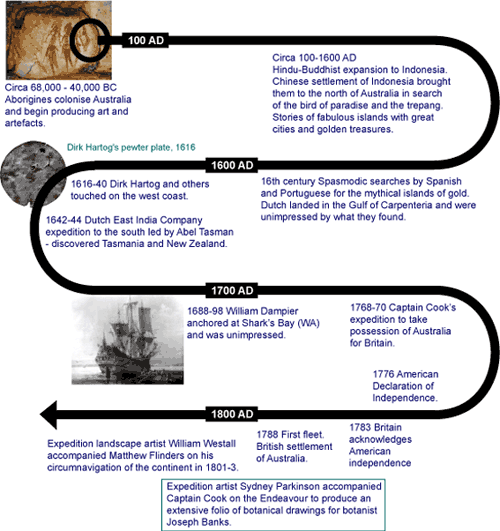
B etween 68,000 to40,000 years ago Aborigines colonised Australia and began producingartefacts. Circa 100-1600 AD, Hindu-Buddhists from southern Indiacolonised Indonesian islands in search of gold, precious spices andreligious converts. They didnt reach Australia, probably due tothe invasion of India by Muslims who subsequently destroyed Hindustates in Indonesia in the 15th and 16th centuries. At around 1500AD, Chinese settlement of the Indonesian islands to the north ofAustralia in search of the bird of paradise and the trepang laterbrought them to the northern coast of Australia. Chinese expansionto the south ended with a palace revolution in 1432 and asubsequent change of policy.
The world became aware of an unknown world to thesouth and tales abounded. Some told that a terrible whirlpoolsucked ships down to an abyss where a monstrous bird would devourthe sailors. Another story was that all the waters drained into avast hole in this southern world, taking ships to an unimaginablefate. The Chinese told of the kingdom of women and the Muslimsreported it as the kingdom of the Antichrist. Tantalisingly,stories were also told about fabulous islands with great cities andgolden treasures. Some ships must have strayed, blown by monsoonsto the northern shores, but if any survived to return and reportwhat had been seen, they contributed little to what was alreadyknown - which was practically nothing at all.
It is thought that these stories deterred Muslim andChinese vessels from sailing too far south, but the Europeans, withtheir advanced navigational technology, scientific developments,with a history of successful exploration and greater reliance onreason developed from the Enlightenment, were able to scoffat such superstitious stories. The Europeans were motivated bygreed for material gain and the spirit of discovery, as well asreligious zeal. They were interested in the tales of unknown lands,riches and the opportunity to save souls. Spanish and Portuguesesearched spasmodically for the mythical islands of gold to thesouth of Java and the unknown southland.
The Dutch were similarly interested in this questand did land on two occasions in the Gulf of Carpenteria region butwere not impressed: there was no good to be found there! Insteadof huge profits and souls to save, all they found was a land ofblack barbarian savages. During the seventeenth century DirkHartog and other Dutch sailors touched onto the west coast ofAustralia.
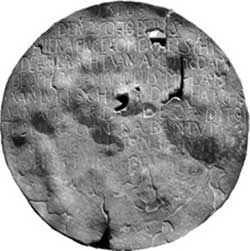
Next page
